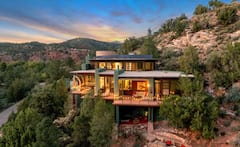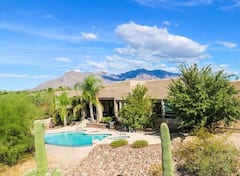Arizona’s landscape is nothing short of dramatic. A millennia of the Earth’s forces has shaped this state’s land into amazing and beautiful natural formations. From the vast Grand Canyon to rich desert landscapes, Arizona has endless opportunities for you to enjoy the Earth’s creations. We’ve found some of Arizona’s best geological sites for a rocky summer vacation.
1. Marvel at the Grand Canyon

If you visit Arizona without visiting the Grand Canyon, you’re doing it wrong.The Colorado River winds through the canyon, slicing through two billion years of the Earth’s geological history. It is an absolute marvel to see. You’ll be left feeling humbled by the power and beauty of nature.
A hands-on way to experience the Grand Canyon is to go hiking through it. For an easy hike, try out the Rim Trail. It’s largely flat, and there are some paved areas. You’ll be treated to quiet walks along the canyon with incredible views.
Grand Canyon (South Rim)
Address: Grand Canyon National Park, East Entrance (Desert View)
Price: from 15 USD upwards for an individual not entering in a vehicle. A vehicle permit can be obtained for 30 USD for a private, non-commercial vehicle and all its occupants
Opening Hours: 24/7, 365 days a year
Duration: at least 3 hours
Access: Take Highway 64 to the South Rim
Website: Grand Canyon National Park
Contact: (928) 638-7888
2. Admire the stars above Monument Valley

Monument Valley Navajo Tribal Park is stunning in its own right. The buttes dominate the landscape, standing ancient and firm against the backdrop of the vast desert. They’re just like, well, monuments. To what or to whom, though, remains the question. It becomes even more awe-inspiring when you learn that Monument Valley is considered sacred to the Navajo.
To take the beauty of Monument Valley up another notch though, try camping in it. There are various campgrounds or cabins that you can choose from. Sunset and sunrise offer incredible views, but it is the sight of the stars that will leave you breathless.
Monument Valley Navajo Tribal Park
Address: Monument Valley, Utah 84536
Duration: At least two days if you’re staying overnight
Access: Take Highway 163 to Monument Valley
Website: Monument Valley Navajo Tribal Park
Contact: (435) 727-5874/ 5879/ 5870
3. Go underground at Kartchner Caverns State Park

Arizona’s summer heat can be searing, so why not escape underground? The Kartchner Caverns State Park stays at a cool 70 degrees Fahrenheit (21 degrees Celsius) all year round. When the Kartchner Caverns were first discovered, they were kept a secret for 14 years so that the caves could be made ready for tourists and still be preserved. It’s one of the largest and most well-preserved living cave systems in the world. A living cave system means that the cave is still growing and changing; expect a moist and damp environment with the occasional drop of water on your head.
Inside, you’ll see stunning natural formations like the longest soda straw stalactite formation, the world’s most extensive formation of brushite moonmilk and the first reported occurrence of turnip shields. If you don’t have any idea what I’m talking about, don’t worry. The tour guides are well-trained and full of information about the various formations in the caverns. There are two tours available. One is of the Rotunda Room, and the other is of the Big Room. Do note that the Big Room is closed to the public in the summer because it’s a nursery for bats.
Tour reservations are required and should be made well in advance.
Kartchner Caverns State Park
Address: 2980 AZ-90, Benson, AZ 85602, United States
Price: Adult tickets are 23 USD, tickets for children between 7 and 13 years old are 13 USD and children below 7 are 5 USD
Opening Hours: 8 am - 5 pm
Duration: at least 1.5 hours
Website: Kartchner Caverns State Park
Contact: +1 520-586-2283
You might be interested in these Airbnbs!
4. Tour the Red Rocks of Sedona on a Pink Jeep (from USD 120.34)

Talk about traveling the outback in style. Don’t let the color fool you though - a Pink Jeep Tour is as rough and adrenaline-pumping as it can get. The tours take you through the outback of Sedona, going off-road over the rugged terrains. You can opt for the Broken Arrow tour, which takes you on a bumpy ride to some of the most famous rock formations. For history buffs, the Ancient Ruin Tour takes you back in time to the ancient dwellings of prehistoric cultures.
You’ll be accompanied the whole time by experienced tour guides who are full of information about local geology, history, plants, and animals. Tours are usually at least an hour and a half, so this is a great afternoon activity where you can sit back and let someone else do the driving. Don’t forget to hang on tight though!
Tours start from 89.95 USD per person and 66.75 USD for kids 12 and under.
Pink Adventure Group
Address: 150 Soldiers Pass Rd, Sedona, AZ 86336, United States
Website: Pink Jeep Tours
Contact: +1 928-204-6473
Sedona: Ancient Ruins Pink Jeep Tour
Duration: 3 hour
5. Go kayaking on the Verde River

Another way to beat the heat is to get in the water! And no, we don’t mean the swimming pool. It might surprise you to find a river in the middle of the desert, but the Verde River is just 30 minutes away from Sedona. In the summer, the water levels are low, so the river is mild, perfect if you don’t have much swimming experience. The Verde River is also surrounded by an incredible landscape, with spectacular canyons and lush forests. Its home to lots of wildlife such as mule deer, beavers, river otters, great blue herons, red-tail hawks, and both golden and bald eagles.
The river is open to the public, so you can bring your own equipment, or just go and splash around in the water. If you don’t have your own equipment though, you can head to Sedona Adventure Tours. They have a do-it-yourself tour that lets you navigate a simple route with exhilarating chutes and calm pools. It’s a fun, adventure-filled way to cool off.
Tours start from 50 USD per person. Do note that children below 13 years have to share a tandem kayak with an adult.
Sedona Adventure Tours
Duration: at least 4 hours
Website: Sedona Adventure Tours
Contact: +1 877-673-3661
6. Squeeze your way through Antelope Canyon

From the outside, Antelope Canyon looks like a crack in the ground. Once you get underground, however, you’ll realise the true beauty that was hiding beneath the surface.
Antelope Canyon is a slot canyon, a deep, narrow canyon that was formed by water rushing through the rocks. It’s an incredible sight. The waves of undulating rock look almost fluid, and you can see shades of red, yellow, purple, and orange. You will have to go on a guided tour to enjoy Antelope Canyon.
Do note that some portions of the canyon are extremely narrow, and will involve steep descents down stairs and ladders. The best time to go is between 10:30 am and 12 noon as the sun’s rays shine through just right, creating a breathtaking sight. For photographers, it’s best to bring a tripod to accommodate the dim light in the canyon.
7. Don’t get pricked by cacti at the Saguaro National Park

The desert isn’t all dry sand and vultures picking at bones! A lush landscape can be found at Saguaro National Park in Tuscon. The park was named for the cactus that it protects – the saguaro. It can grow to over 70 feet (21 meters) tall, with many branches, but they have to be at least 70 years old before they grow an arm.
The park has two districts, one in the east and one in the west, separated by the city of Tuscon. Both offer opportunities to see the rich desert flora and fauna, and both offer hiking trails. The hiking trails range from paved, accessible paths, to trails that lead high into the mountains. You will need to pay for entry. A weekly pass ranges from 5 USD to 10 USD.
Saguaro National Park
Price: from 5 USD upwards
Opening Hours: You can walk into the park 24/7, but the gates are open for vehicles from sunrise to sundown
Duration: around 3 hours required.
Website: Saguaro National Park
Contact: +1 (520) 733-5153
8. Let nature petrify you at the Petrified Forest National Park

The Petrified Forest National Park is home to large pieces of petrified wood, as well as fossils of fish, plants and reptiles. It’s a living laboratory, with new fossils still being found by palaeontologists. The most prominent feature of the Petrified Forest is the petrified wood, which is hard, glossy pieces of ancient trees that have been replaced over the millennia by stone. The park is a place where dinosaurs once roamed and ancient civilisations made their home. It’s hard not to feel awed as you explore it.
The best way to experience the Petrified Forest National Park is on foot, and there are many trails to be found within the park. The Painted Desert Rim Trail offers spectacular views of the Painted Desert, while the Crystal Forest is one of the best trails to enjoy the petrified wood deposits.
Petrified Forest National Park
Address: Northeastern Arizona, about 50 miles from the New Mexico border on Interstate 40
Price: from 10 USD upwards
Opening Hours: The park is open year-round, except on Christmas Day. Opening hours will vary throughout the year. Click here for the opening hours
Access: From the north and west side of greater Phoenix travel Interstates 17 North and 40 East, passing through Flagstaff (259 miles / 417 kilometers).From the eastern side of greater Phoenix travel Highways 87 North to Payson, 260 East to Heber, 377 North to Holbrook, and 180 South to the park (215 miles / 346 kilometers)
Website: Petrified Forest National Park
Contact: +1 (928) 524-6228
9. Hoover Dam is man-made, but it’s still incredible

One of the world’s greatest engineering marvels, Hoover Dam straddles the border between Arizona and Nevada. The dam is 726 feet (221 meters) high and 1,244 feet (379 meters) long. It holds back the Colorado River, creating Lake Mead. The dam is stunning to look at, just for its sheer size, especially when you consider that it is man-made.
You can opt for a tour of the dam, where you will learn about the history of the dam, as well as its technical aspects. The tour allows you to go into parts of the dam, which is sure to thrill curious kids.
Hoover Dam
Address: The Dam does not have an address. These are its GPS coordinates: N 36.016222, W -114.737245
Price: Check official website depending on any activities
Opening Hours: 9 am - 5 pm. Tickets have to be purchased by 4.15 pm
Duration: Tours range from half an hour to an hour. Plan at least 2 hours to tour all the facilities
Website: Hoover Dam
10. See the world through Papago Park’s Hole-In-The-Rock
As you might have guessed from the name, Papago Park’s main attraction is the Hole-In-The-Rock. It’s a red sandstone butte that was created 6 to 15 million years ago. Erosion wore a series of holes in the rock, creating a unique formation that looks like it could be inhabited by giant ants.
You can climb up a relatively easy trail into the biggest hole, where you’ll be greeted with beautiful sights of Phoenix. There is a near-constant wind blowing through the hole, so it’s a nice way to cool off too. After you’re done hiking, you can have a picnic at one of the nearby fishing lakes, or go biking on some of the trails in the park too.
Papago Park
Address: 625 N Galvin Pkwy, Phoenix, AZ 85008, United States
Price: Free
Website: Papago Park
Contact: +1 (602) 261-8318
11. Get a different view of the Grand Canyon from the North Rim

Most people only experience the Grand Canyon from the South Rim. It’s where all the tour buses go. However, the North Rim offers a much more serene Grand Canyon experience as it’s less developed and harder to get to, so it’s therefore also less crowded. The trouble getting there is worth it though. The North Rim is at a higher elevation than the South Rim, so it offers spectacular views.
You will also be near to other national parks such as the Zion National Park and Bryce Canyon National Park. You can visit and explore the three parks over the course of a few days.
Grand Canyon North Rim
Price: from 15 USD upnwards for an individual not entering in a vehicle. A vehicle permit can be obtained for 30 USD for a private, non-commercial vehicle and all its occupants
Opening Hours: Open May 15 to October 15 annually
Duration: around 3 hours required
Access: Take Highway 67 to the North Rim
Website: Grand Canyon National Park
Contact: +1 (928) 638-7888
12. Get too close to the edge of the Horseshoe Bend

For another less-famous part of the Grand Canyon, stop by the Horseshoe Bend. It’s a meander in the Colorado River that’s shaped like a horseshoe (who would’ve guessed!). It’s a spectacular sight.
The area surrounding the Horseshoe Bend is undeveloped. The trail starts from a car park, and is about three quarters of a mile (1.2 kilometers). It’s an easy trail, but it can get hot in the summer. Once you reach the edge of the Horseshoe Bend, you have to be careful because there are no safety barriers! It can get crowded with tourists sometimes, so remember to spread out along the rim and stay safe.
Horseshoe Bend
Price: Free
Duration: at least an hour
Access: From Page, AZ drive south on Highway 89 to between mileposts 544 & 545. Look for the exit lane and prominent dirt road on the west side of the road, which you can drive a short distance on to the parking area
Website: Horseshoe Bend
Tip from Content Creator


Horseshoe Band and Lake Powell travel tips:
-It's just 6km from Page.
-You do not need to pay an entrance fee to visit Horseshoe Bend, but parking costs $10 for cars ($5 for motorcycles).
-From the parking lot, you need to walk to Horseshoe Bend. The trail is easy and is a 2.4 km long round trip. There are also canopies along the trail to shelter from the sun.
-In addition to Antelope Canyon, around Horseshoe Bend is the beautiful Lake Powell.
-Lake Powell is included in the vast Glen Canyon National Recreation Area region between Arizona and Utah.
What to see of Lake Powell:
- Navajo Mountain Viewpoint
- Wahweap Overlook
- Lone Rock Beach
- Rainbow Bridge (accessible only by water, so either by organized tour or by renting a boat)
- Reflection Canyon, although it is really difficult to reach this incredible place
In any case, there are many activities that can be done on this lake, but experiences such as kayaking and boat trips should definitely be booked in advance.
13. Admire the blue of the Glen Canyon National Recreation Area

The Glen Canyon National Recreation Area is a great place for water-based and back-country activities. The Recreation Area surrounds Lake Powell, a man-made reservoir that was created by building the Glen Canyon Dam and flooding Glen Canyon.
Lake Powell is one of the most popular water skiing and house-boating areas in the United States. You can take a boat tour to the Rainbow Bridge, and swim, kayak, cycle, or hike at Glen Canyon.
Glen Canyon National Recreation Area
Address: 4304 Bullfrog, Lake Powell, UT 84533, United States
Contact: +1 928-608-6404
14. Check out the underside of Tonto Natural Bridge State Park

The Rainbow Bridge in Utah is probably the most famous natural bridge, but tucked away in a little valley, surrounded by a forest of pine trees, is the Tonto Natural Bridge. It’s the largest natural bridge in the world. The limestone bridge was formed when water from a creek seeped into the fractures of a wall of mineral deposits and eroded the wall.
The Tonto Natural Bridge State Park offers four trails: the Waterfall Trail, Gowan Trail, Pine Creek Trail and Anna Mae Trail. The Waterfall Trail is the shortest and easiest of the four. The other trails will take you under and behind the bridge. Do note that some parts of the trails are undeveloped and will need you to jump from boulder to boulder. Proceed with caution!
Tonto Natural Bridge State Park
Address: Hwy 87 North of Payson, Payson, AZ 85547, United States
Price: Adults: 7 USD, Youth (7 - 13) 4 USD, children below 6 enter for free
Opening Hours: 9 am - 5 pm
Duration: at least an hour, depending on which trail you take
Website: Tonto Natural Bridge State Park
Contact: +1 928-476-4202
15. Visit a zoo, aquarium and botanical garden rolled into one at the Arizona-Sonara Desert Museum

Don’t let the word museum fool you. Around 85 percent of the Arizona-Sonara Museum is outdoors, and it combines a zoo, aquarium, and botanic garden. The Arizona-Sonara Museum aims to foster love, understanding, and appreciation for the Sonaran Desert, and it does this through a series of interactive and hands-on exhibits that feature the plants and animals that live there.
The exhibits try as much as possible to recreate what a natural habitat would look like, while giving visitors the chance to see what happens in that habitat. For example, some exhibits are cross-sections of burrows, while others feature fibre-fencing which is almost invisible.
At the museum, guests can see a wide range of animals, ranging from desert toads to kit foxes and coyotes. It’s a fascinating way to learn more about the ecosystems of the Sonaran Desert, and is sure to leave you with an appreciation for nature and how it adapts to inhospitable regions. It’s best to go early or late in the day, as it will be less hot and the animals will be more active.
Arizona-Sonora Desert Museum
Address: 2021 N Kinney Rd, Tucson, AZ 85743, United States
Price: 20.50 USD for ages 13 - 64, 8 USD for ages 3 - 12. Children below 3 enter for free
Opening Hours: 7:30 am to 5 pm from March to September, and 8:30 am to 5 pm from October to February
Duration: at least 2 hours
Access: Eastbound: exit I-10 at Speedway Blvd and turn right. After 12 miles (19 kilometers), turn right onto Kinney Road. In about 2.5 miles (4 kilometers), the Desert Museum will be on your left
Westbound: exit I-10 at Speedway Blvd and turn left. After 12 miles (19 kilometers), turn right onto Kinney Road. In about 2.5 miles (4 kilometers), the Desert Museum will be on your left
Website: Arizona-Sonora Desert Museum
Contact: +1 520-883-1380
Ready for an igneous vacation?
Is your inner geography / geology nerd already looking for plane tickets to Arizona? Before you head off, remember that Arizona is extremely hot in the summer. Always check the websites of the places that you plan to head to beforehand to check if they have any alerts about the weather.
A lot of the activities in this article involve hiking, so wear comfortable shoes, have some form of protection from the sun, and bring plenty of water with you. Just keep safety precautions and common sense in mind, and you’ll be well on your way to a rocking vacation!
History
Get Trip101 in your inbox
Unsubscribe in one click. See our Privacy Policy for more information on how we use your data


























Create an account to